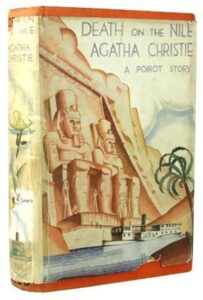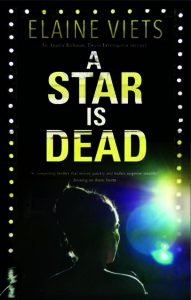By Elaine Viets
I’m starting my sixth Angela Richman, Death Investigator mystery by returning to my comfort read, Agatha Christie. After all, she’s sold a billion books in English and another billion in foreign languages.
Why read an author who’s been dead for nearly 45 years?
 Because her writing is timeless. I still learn from her. Here are three ways:
Because her writing is timeless. I still learn from her. Here are three ways:
(1) Agatha Christie’s character descriptions are superb.
Even the most unimportant characters are carefully described.
In Death on the Nile “smooth-footed, deft-handed waiters ministered” to Hercule Poirot’s table, serving him an excellent meal.
 And while the butler didn’t commit this murder, his brief appearance is memorable:
And while the butler didn’t commit this murder, his brief appearance is memorable:
“A few minutes later she was being ushered into the long stately drawing room, and an ecclesiastical butler was saying with the proper mournful intonation, ‘Miss de Bellefort.’”
I love those phrases –”an ecclesiastical butler” “with the proper mournful intonation.” I can almost hear him intone her name.
(2) Agatha Christie finds fresh ways to describe series characters.
It’s tempting for series writers like myself to repeat the same descriptions of our main characters, book after book. But we have to be careful. Readers are smart enough to recognize boilerplate.
Here’s Agatha’s description of Hercule in After the Funeral. This is the 29th mystery in the Poirot series, but she still comes up with a new description:
“There were no curves in the room. Everything was square. Almost the only exception was Hercule Poirot himself, who was full of curves. His stomach was pleasantly rounded, his head resembled an egg in shape, and his moustaches curved upwards in a flamboyant flourish.”
Hercule is talking to Mr. Goby, an expensive operative who acquires outre information. Here’s Agatha’s clever description of a nondescript operative:
“Mr. Goby was small and spare and shrunken. He had always been refreshingly nondescript in appearance and he was now so nondescript as practically not to be there at all.”
Mr. Goby has to deliver a long list information that could have been quite dry. But Agatha livens it up with a funny bit. Here’s how Mr. Goby gives his report to Poirot:
“He was not looking at Poirot because Mr. Gobi never looked at anybody. Such remarks as he was now making seemed to be addressed to the left-hand corner of the chromium-plated fireplace curb.” He delivers his first round of information that way.
For the second batch, Mr. Goby “shifted his gaze to an electric plug socket.”
The third burst of info is given while he “winks at a lampshade.”
And finally, Mr. Goby finishes his information “by nodding his head at a cushion on the sofa.”
Mr. Goby never appears in this book again, but Agatha has found a good way to make what could have been a boring recitation of facts entertaining.
(3) Agatha Christie knows how to skip esoteric discussions that can bog down a scene.
Hercule is back at that fine dinner, and the host says, “‘You will enjoy your dinner, Monsieur Poirot. I promise you that. Now as to wine–’
“A technical conversation ensued, with Jules, the maitre d’hotel, assisting.”
Agatha also uses this technique to avoid repetitious dialogue from scene to scene.
That’s how I prep for my newest novel. I don’t call it procrastination, though Agatha has some 80 books and short stories.
What do you do before you start your novels?
***********************************************************************
 A Star Is Dead – “witty dialogue and well-defined characters” says Publishers Weekly – sold out of its first printing. Buy it here:
A Star Is Dead – “witty dialogue and well-defined characters” says Publishers Weekly – sold out of its first printing. Buy it here:


Unfortunately, I do anything that will put off starting the next book. I even clean. And it’s not that I’m not excited about the story but that first scene is painful.
I do anything but clean, Patricia, but I feel your pain. One of my writer friends shingled his roof.
Good question, Elaine. My current almost-ready-for-the-editor WIP is a stand alone, and first, I have to decide if I’m going to continue my other series, and if so, which one. That’s about all my brain can handle these days.
Making that “do I continue the series” question is a tough one, Terry. Good luck.
Elaine, the lines you quoted by Agatha remind me why reading the book is almost always better than seeing the movie. Those wonderful descriptions disappear in cinema.
This is the first time in years that I haven’t had another book already in the pipeline. It’s an uncomfortable feeling, floundering around, searching for a plot. Also, trying to decide if the new story should take place pre-Covid or be set in the present. That problem keeps me awake at night.
Not having a book in the pipeline can make any writer feel uneasy, Debbie. But your track record, you’ll be back on track soon. Why not try an FB poll and see if your readers want to read about Covid yet?
I’ve had editors from two different publishers tell me to NOT address Covid in my stories, that readers do not want to hear about it any longer and they sure don’t want to read about it. Since that’s what I wanted to hear, that’s what I’m going with. 🙂
I think the editors are right, Patricia. It’s taken the USA years before we could read Vietnam stories. Covid and its pain is still too fresh and raw.
Everything I’ve seen from readers says “absolutely no pandemic stories” and I’m with them. My book club is reading “The Book of Lost Friends” this month, and I’m having a terrible time dealing with the sections dealing with a freed slave right after the Civil War.
Being so new (first novel in the pipeline), I can hardly contribute to this discussion!
I do have several other stories (novels or novellas…the jury’s still out) in the works, and it seems when it’s time to push forward with one, I dilly-dally around reading through my “what if” questions, last lines, brainstorming docs, etc., and, of course the daily TKZ encouragement, then settle and get going. It seems to work. And if it doesn’t, I threaten myself with cleaning the bathrooms, or the refrigerator. That always works… 🙂
I spent my teen years reading every AC novel I could get my hands on. Loved her.
I read AC when I was a teen, too, Deb. Now I find she’s definitely worth re-reading. As for your current habits, you are definitely a writer. Get to work, woman!
My obligatory history of narrative comment. (I straighten my glasses and speak to my college class.) Narrative style changes over time. Reader expectations of narrative change over time. You can learn from the old masters, but the new masters in your genre will teach you how to reach current readers. (I glance nervously at the door to check if any of my fellow teachers are within earshot.) But read Christie’s THE MURDER OF ROGER ACKROYD for a tour de force of narrative misdirection.
Okay, back to the subject, here’s a bit of info on the beginning of most early novels that you sweated out with blood and misery. It will almost always be deleted. Nothing will remain because you were getting the story and characters straight in your head in a massive vomit of backstory, setting, and character development. Your writing teacher, editor, or critique readers will tell you to delete it, and you will realize they are right. So, don’t be paralyzed by that blank screen. Just start typing and clean up the dreck of those first pages during rewrite. The roof shingles and the dirty kitchen floor can wait.
LOL. So true, Marilynn. All my early purple prose was scrubbed by my editors — and rightly so.
“Ah,” I say, making a cone-shaped apparatus of my fingers and thumb, then planting a light kiss on the end of it. “Agatha.”
Good one, Jim.
Superb and motivational examples–thanks, Elaine!
Thanks, Rick.
What do I do before I start my novels? I try to come up with a couple of characters that the reader can tolerate spending time with, a slam-bang opening situation, and sometimes a meaty McGuffin. Once I have these in my head I can’t resist writing the opening scene.
Re character descriptions: One of my favorite gimmicks it to describe a character who dies soon after being introduced in exactly the same way as one who will become an enduring supporting character. Makes the readers nervous!
Nice tip, Robert.
When my grandfather passed away (I was a kid) I inherited his collection of Agatha Christie books. Had that same edition of ‘After the Funeral’. That cover always gave me the absolute creeps. Still does!
I remember trying to read it but I’m not sure if I finished it at the time or it was a bit beyond me and was abandoned. I’ll have to dig it up and try again…
Is that the cover with the gravestones, JA? Because it’s creepy any time.
Hi Elaine, it was the one above featuring the nun and the axe – think it’s the combination of her expression and the bloodied edge that really gets me…
*shiver*
Yep, the nun and ax would do it for me, too, JA.
I agree–I just read Christie for the first time in a number years recently, her Marple novel “Nemesis,” and her talent for telling description (along with her brilliance at plotting a mystery) endures.
Before beginning to write a new novel, I usually create a novel journal where I brainstorm, jot down notes, etc, and then continue to journal in it as I write the novel.
My published novels have all been fantasy or science fiction, and invariably include a mystery or at the very least, a crime element. Back in March, I felt the urge to do something I’ve thought about for years–write a mystery novel, and specifically, set it in a library (I retired comparatively young last December after 32 years in public library service 🙂
So, I’ve been reading a lot of mysteries. I’ve always enjoyed them, but now I’m looking at finally writing a straight mystery (as opposed to an urban fantasy with a mystery element), and reading them with an eye to that has feels like great creative prep work. It’s also great fun 🙂
Thanks for stopping by today, Dale. An insider’s view of a library is always fun to read. Let us know when it’s published.